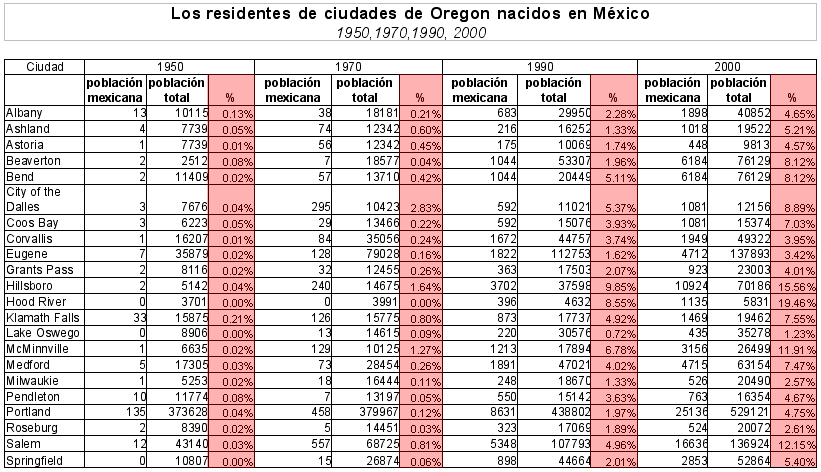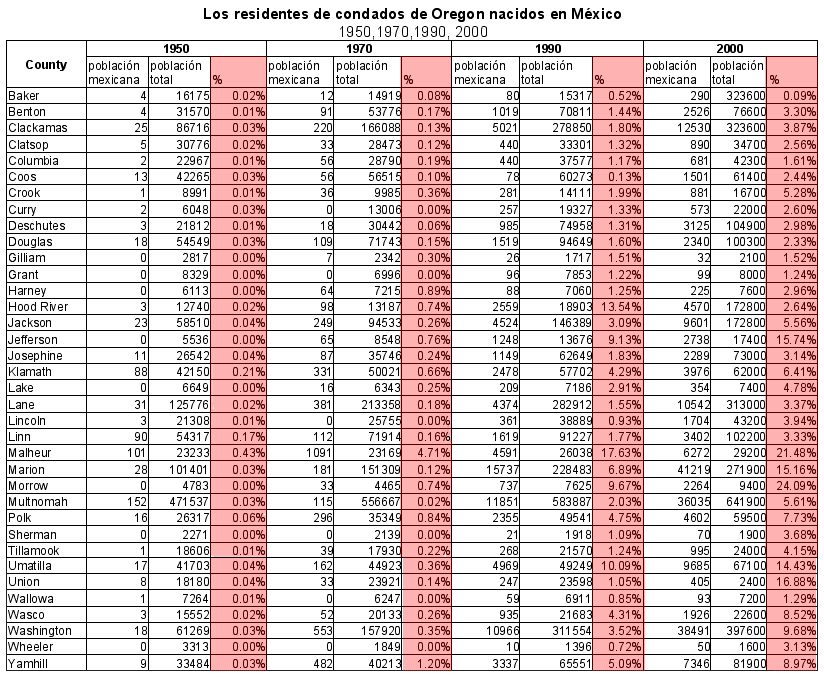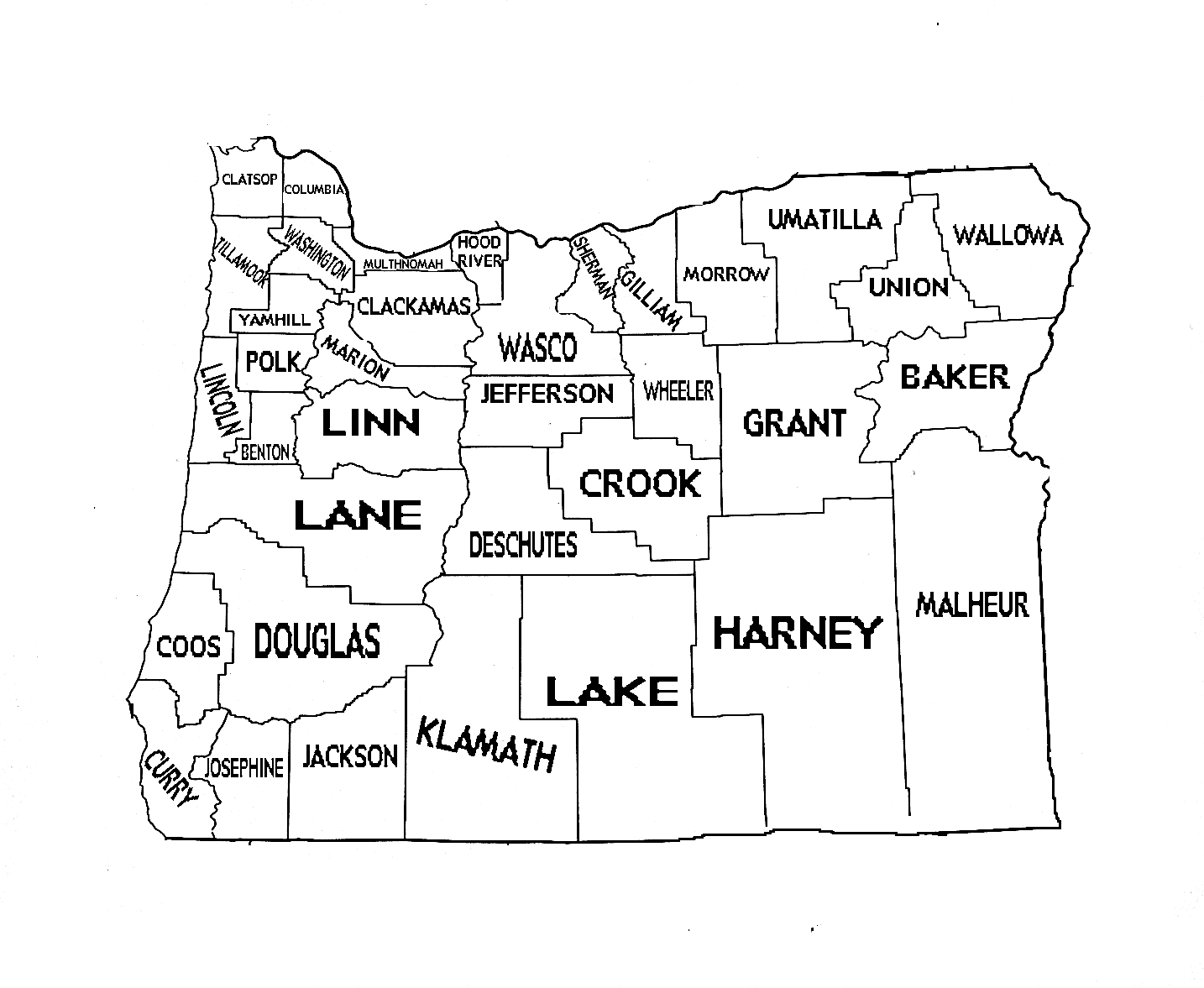
|
Title |
La población mexicana en Oregón: Un vistazo histórico |
|
Unit/Activity No. |
Immigration Unit 2/Activity 2 |
|
Geography Topic |
historical demographics |
|
Language Topic |
community |
|
Language Function |
describe, comparein past and present time frames |
|
Language Standard |
1.1, 3.1 |
|
Geography Standard |
9, 12, 17 |
| Step 1. | Before class prepare the handouts and transparencies. |
| Step 2. | Pass out white boards and dry erase markers to students. |
| Step 3. | Review numbers with students by calling out numbers and having them write down what they hear. Spot check their answers as students hold up their boards. Review and explain numbers as necessary. Focus first on three digit numbers (0-100) and gradually progress to four, five, six and seven digit numbers as students are ready. |
| Step 4. | Continue the review session by having students create numbers to read to their partners so they can write them down. For a follow-up, call on 2-3 students to share their numbers with the entire class. |
| Step 5. | As a final review of numbers before moving on to the raw data, read math problems to the students and have them write the answers: 150 y 350 son ________; 400 dividido por 4 son ________, etc. At this point, review converting fractions into percentages with students to get them ready for the next section of the activity. (Use ratios relevant to the class, e.g. the percentage of girls and boys in the class, in the school, the number of each letter grade on the last test, etc.) |
| Step 6. | Give students the handouts with the two different tables of census data (Handouts 1 and 2). Randomly read numbers from each decade and have students guess the city or county (listening comprehension), then ask students to read the populations for cities or counties you name (production). |
| Step 7. | Have students choose three cities and read the populations to their partner. The partner will guess the correct city. Make sure the student reading the numbers identifies the corresponding decade for each city to simplify the guessing. (En 1950, la población de esta ciudad fue de _____ habitantes. ¿Qué ciudad es?) |
| Step 8. | Choose your hometown or a nearby city and practice together as a class figuring out the percentage of Mexican-born residents in the last four census years. Students can use calculators or do the math on paper. Practice reading the percentages, remembering to use the definite article (e.g. El 23 por ciento de los habitantes son de origen mexicano.). |
| Step 9. | Pass out the worksheets (Handout 3) to the students and go over the instructions. Students will first work individually to calculate the percentages for their assigned cities. They will then interview one another to fill out their tables with the missing data. Use Transparency 1 to guide students in this activity. |
White boards, dry erase markers (Slate boards and chalk can also be used. If neither white boards nor slates are available, pass out scratch paper to students to use to practice numbers.), and calculators


Review the following vocabulario útil in Step 2.
|
0 |
Cero |
1000 |
mil |
|
10 |
Diez |
2.000 |
dos mil |
|
20 |
veinte |
3.000 |
tres mil |
|
30 |
treinta |
15.000 |
quince mil |
|
40 |
cuarenta |
1.000.000 |
un millón (de) |
|
50 |
cincuenta |
to add |
sumar |
|
60 |
sesenta |
to subtract |
restar |
|
70 |
setenta |
to multiply |
multiplicar |
|
80 |
ochenta |
to divide |
dividir |
|
90 |
noventa |
percentage |
el porcentaje |
|
100 |
Cien |
per cent |
por ciento |
|
101 |
ciento y uno |
figure, number |
la cifra |
|
200 |
doscientos |
|
|
|
300 |
trescientos |
|
|
|
400 |
cuatrocientos |
|
|
|
500 |
quinientos |
|
|
|
600 |
seiscientos |
|
|
|
700 |
setecientos |
|
|
|
800 |
ochocientos |
|
|
|
900 |
novecientos |
|
|
In this activity, students will manipulate census data from four time periods to examine the growth of the Mexican population in Oregon. A review of numbers is built into the beginning of the activity to warm up students for their analysis of the census information.
The same activity worksheet (Handout 3) can be given to Students A and B. They will be completing the same activity for different cities and then recording each other’s information on their sheet.
Handout 1

Handout 2

Handout 3
La población mexicana en Oregón: Un vistazo histórico
Estudiante A: Usando los datos de la tabla del censo, calcula el porcentaje de la población mexicana en Corvallis, Hillsboro, Pendleton, Roseburg y Salem para cada año indicado. Escribe los números en la tabla. Después, entrevista a tu compañero(a) y apunta sus resultados en tu hoja.
Estudiante B: Usando los datos de la tabla del censo, calcula el porcentaje de la población mexicana en Ashland, Astoria, Bend, Eugene y Portland para cada año. Escribe los números en la tabla. Después, entrevista a tu compañero(a) y apunta sus resultados en tu hoja.
|
Ciudades |
1950 |
1970 |
1990 |
2000 |
|
Ashland
|
|
|
|
|
|
Astoria
|
|
|
|
|
|
Bend
|
|
|
|
|
|
Corvallis
|
|
|
|
|
|
Eugene
|
|
|
|
|
|
Hillsboro
|
|
|
|
|
|
Portland
|
|
|
|
|
|
Pendleton
|
|
|
|
|
|
Roseburg
|
|
|
|
|
|
Salem
|
|
|
|
|
Transparency 1

Transparency 2
This transparency is the same as Handout 1.
(1) Have students use their percentages from the county information to create a cloropleth map. Students can also choose to make a series of maps of the counties, one for each year represented in the graph, illustrating the growth in residential numbers.
(2) Have students make predictions to explain why the numbers change as they do. Offer guiding questions, e.g., ¿Qué ciudades han visto los cambios más grandes en su población de origen mexicano? ¿Dónde están estas ciudades? (¿En qué región del estado?) ¿Qué actividades económicas son importantes en esta región? Review the “push-pull” factors of immigration (http://www.scalloway.org.uk/popu14.htm). Have students guess which factors may help explain these demographic changes.